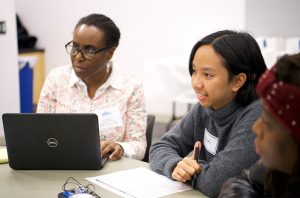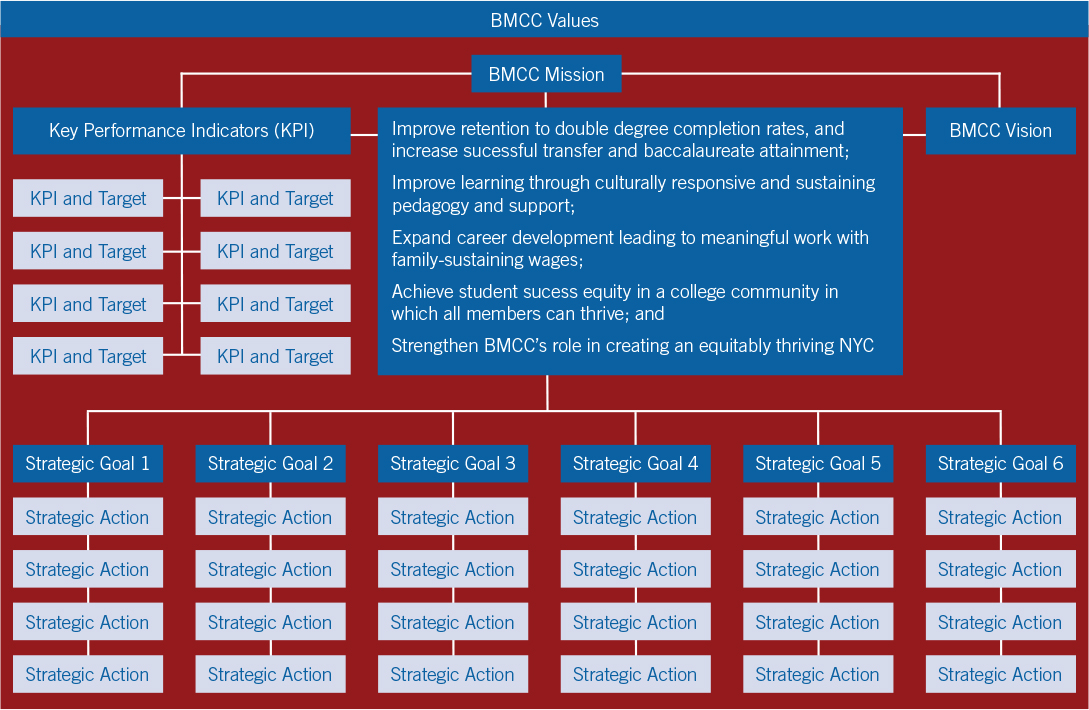 The priorities, goals, actions, and KPIs listed below reflect the work conducted during both phases of the Designing for Success process. This final version was also guided by six principles included in the charge to the strategic planning subcommittees. These were:
The priorities, goals, actions, and KPIs listed below reflect the work conducted during both phases of the Designing for Success process. This final version was also guided by six principles included in the charge to the strategic planning subcommittees. These were:
- recommend specific actions to achieve the objective, including improvements or changes to policies, practices, and processes;
- provide an evidence base for the recommendations, including faculty research and findings from BMCC, CUNY and external sources;
- recommend a communications strategy to inform and engage the college community in recommended actions;
- identify faculty and staff development needs;
- identify the resources needed to accomplish the recommended actions; and
- identify strategies to advance equity and inclusion through recommended actions.
While the process was guided by design thinking and intentional redesign, leadership ensured that the process was organic with substantial opportunities for involvement. This resulted in a final strategic planning framework that would communicate institutional priorities, actions designed to take what works to scale, and a set of metrics and targets that the College is accountable to. The framework demonstrating the connection between these elements, including the role of mission, vision, and values, is included below.
Strategic Priorities
- Improve retention to double degree completion rates, and increase successful transfer and baccalaureate attainment;
- Enhance learning through culturally responsive and sustaining pedagogy and support;
- Expand career development leading to meaningful work with family-sustaining wages;
- Achieve equity in these outcomes in a college community in which all members can thrive;
- Foster a receptive and compassionate college culture where students feel valued, encouraged, supported, and hopeful; and
- Strengthen BMCC’s role in creating an equitably thriving NYC.


Strategic Goals
Strategic Action 1.1: Establish a summer bridge program for At-Promise students that incorporates known student success components
Strategic Action 1.2: Improve the effectiveness of in-person and virtual enrollment services
Strategic Action 1.3: Implement virtual helpdesk and chat applications in multiple languages and across multiple departments (LiveHelpNow)
Strategic Action 1.4: Develop individualized student success maps, including a financial plan, for every new student (Navigate)
Strategic Action 1.5: Enhance the personalization of the student experience through innovative tools such as digital storytelling, how-to tutorials, and podcasts
Strategic Action 1.6: Create a student communication hub that becomes the single source for students seeking assistance plus strategically directs all outgoing communications to students
Strategic Action 1.7: Build a student navigator corps with Federal Work Study students to assist students through the enrollment process and guide them to the first day of college
Strategic Action 2.1: Design and implement a rebranded, mandatory first-year experience through integrated for-credit, first-semester seminars and non-credit FYE programming that include equity, inclusion, and anti-racism components
Strategic Action 2.2: Reduce the percentage of first semester students entering probation and increase the percentage of students returning to good academic standing from probation
Strategic Action 2.3: Significantly increase the percentage of students with a cohort experience*
Strategic Action 2.4: Expand the implementation of trauma-informed and culturally-responsive and sustaining pedagogies and support both in person and virtually
Strategic Action 2.5: Implement and utilize holistic student intake forms to enhance the educational experience (Navigate)
Strategic Action 2.6: Ensure consistency of language and expectations related to key student support units including academic advising, counseling, financial aid, and learning resources available at BMCC
Strategic Action 2.7: Design and implement an online orientation on the current LMS before they meet with an academic advisor or faculty member
Strategic Action 3.1: Expand industry partnerships across all sectors to increase the percentage of students participating in paid internships, including remote field placements, and receiving scholarships
Strategic Action 3.2: Increase the utilization and leveraging of academic and career communities for academic, co-curricular, and extra-curricular programming both in person and virtually
Strategic Action 3.3: Increase the percentage of students participating in career planning activities and coursework
Strategic Action 3.4: Strengthen the effectiveness of the Federal Work Study Program by increasing approved career preparation internships, including virtual opportunities, and enhancing proven student success initiatives (i.e., using FWS to expand peer mentoring, peer tutoring, and supplemental instruction)
Strategic Action 3.5: Embed career development exploration, including power and virtual workplace skills, into introductory courses and student programming
Strategic Action 3.6: Grow, integrate, and leverage the network of BMCC alumni to support student career development, internship opportunities, and alumni-student networking
Strategic Action 4.1: Expand the use of Supplemental Instruction and Peer-Assisted Learning for targeted student populations both online and in-person learners
Strategic Action 4.2: Increase the percentage of students utilizing tutoring services both online and in-person learners
Strategic Action 4.3: Determine the policies and implement the practices, including integration of college systems, required to effectively bring academic early alerts and other targeted outreach efforts to scale (e.g. Connect2Success)
Strategic Action 4.4: Increase faculty, staff, and student awareness and utilization of the Co-Curricular Transcript (CCT)
Strategic Action 4.5: Develop, implement, and evaluate an integrated online learning ecosystem to increase student success in online degree courses and programs
Strategic Action 5.1: Expand the use of pedagogical, educational and student support, and organizational practices and approaches that reduce gaps in student success
Strategic Action 5.2: Expand access to in-person and virtual academic and student support services for all student populations and ensure that virtual services mirror best practices for in-person services in multiple languages
Strategic Action 5.3: Re-imagine and redesign both the College’s physical and virtual space to increase a sense of welcoming, create in-person and virtual communities, and enhance student learning and success
Strategic Action 5.4: Scale in-person and virtual programming and interventions to bolster a sense of belonging within the College community
Strategic Action 5.5: Implement professional development activities and hiring practices for faculty and staff that prioritize strengthening the College’s culture of care in and outside the classroom
Strategic Action 5.6: Prioritize meeting students’ basic needs in regard to food, housing, and transportation including the development of a meal plan
Strategic Action 5.7: Partner with community-based organizations, business and industry, and governmental agencies to advocate for addressing and alleviating student, faculty, and staff basic needs
Strategic Action 5.8: Finalize and implement the institutional commitments that emerge from the Caring Campus Initiative
Strategic Action 6.1: Raise the profile of the college throughout NYC and beyond by celebrating alumni, faculty and staff research, and nationally recognized student success initiatives and programming
Strategic Action 6.2: Strengthen, grow, and leverage academic, social, and economic partnerships to benefit students, the college, and New York City
Strategic Action 6.3: Utilize, support, and publicize faculty and staff research on student success to improve learning, retention, graduation, transfer, and other educational outcomes
Strategic Action 6.4: Develop and implement a plan that addresses environmental, public health, economic, and educational sustainability
Strategic Action 6.5: Strengthen the alignment between academic programming and workforce development to include expanding career pathways, the number and scope of certificate programs, and expanding credit for prior learning
Strategic Action 6.6: Increase the number of stackable credentials, microcredentials, and badges within the College’s academic programs
Strategic Action 6.7: Develop new apprenticeships and academic programming that aligns with career opportunities that provide family sustaining wages
Strategic Action 6.8: Increase the number of academic programs utilizing industry advisory boards
Strategic Action 6.9: Demonstrate leadership and a commitment to increase equity, foster inclusion, and dismantle systematic racism
Key Performance Indicators and Targets
| Indicator | Metric | 2025 Target |
|---|---|---|
| New Student Enrollment Yield | Ratio of application to enrollments | 25% |
| New Students Receiving Success Maps | First-time Full-time student who complete success maps | 100% |
| Probation Rate for New Students | First-time Full-time rate of student entering probation after first semester | 20% |
| Students returning from probation | Percentage of students on probation who return the next semester | 70% |
| Fall to Spring Retention Rate (Disaggregated) | First-time Full-time first semester retention rate | 75% |
| Fall to Fall Retention Rate (Disaggregated) | First-time Full-time first year retention rate | 70% |
| English Gateway Pass Rate in First Year (Disaggregated) | First-time Full-time English Pass Rate | 70% |
| Math Gateway Pass Rate in First Year (Disaggregated) | First-time Full-time math Pass Rate | 50% |
| Math and English Gateway Pass Rate in First Year (Disaggregated) | First-time Full-time math and English pass rate | 45% |
| Tutoring Services Utilization Rate | Percentage of students attending at least one tutoring session each year | 33% |
| 3-year Graduation Rate (Disaggregated) | First-time Full-time graduation rate | 40% |
| Transfer rate of Graduates (Disaggregated) | First-time Full-time transfer rate | 75% |
| 6-year Graduation or Transfer Rate (Disaggregated) | First-time Full-time transfer or graduation rate | 50% |
| 4-Year Bachelors Attainment Rate | BMCC graduate bachelor’s attainment rate | 67% |
| Cohort Experiences | Percentage of entering students receiving a cohort experience within their first year | 100% |
| Participation in Paid Internships | Percentage of graduating students with a paid internship | 25% |
| Participation in Career Planning Coursework | Percentage of graduating students who have completed career planning coursework | 50% |
| Co-Curricular Transcript (CCT) Utilization Rate | Percent of students with CCT entries upon graduation | 25% |
| Degree-seeking Students Earning 30 or More Credits in their First Year (Disaggregated) | First-time Full-time students earning 30 or more credits | 20% |
| 3-year Faculty Scholarship Average | Running average of faculty publications and scholarship activity | 650 |
| Faculty Satisfaction | Ratings from the COACHE survey on research, teaching, and service | 3.0/3.5/3.75 |
| Staff Satisfaction | Satisfaction with work/life balance and professional growth | 75%/60% |
| Annual Grant Applications | Targeted number of annual submitted applications | 52 |
| Fundraising | Total fundraising dollars raised annually | $5.0 mil |
| Non-credit to Credit Transition | Percent of students enrolling in credit coursework from CUNY Start or non-credit | 70% |


